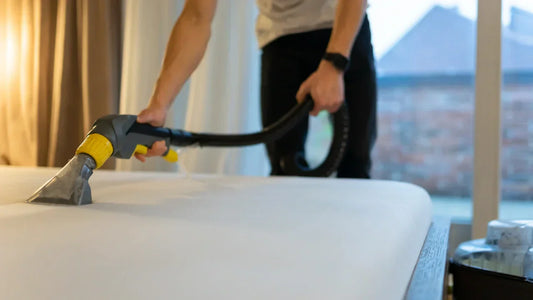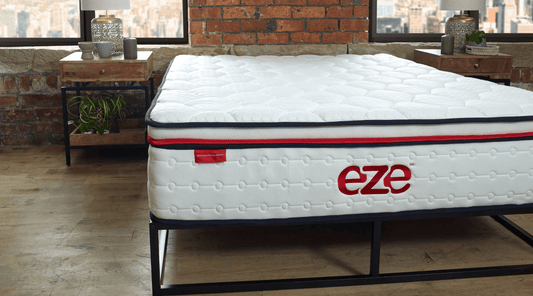Shopping for a new mattress and curious about memory foam?
You’re in the right place.
In this guide, we’ll explore:
-
The key benefits of memory foam mattresses
-
How memory foam compares to spring and hybrid alternatives
-
Whether memory foam is right for your sleep style
Let’s dive in.
(If you're ready to explore your mattress options, be sure to check out our collection of hybrid mattresses that use memory foam technology.)
Quick Summary: Are Memory Foam Beds Worth It?
Before we get into the details, here’s a quick snapshot of what memory foam mattresses offer:
Pros
-
Excellent pressure relief for side and back sleepers
-
Outstanding motion isolation for couples
-
Hypoallergenic and quiet
-
Great for spinal alignment and joint support
Cons
-
Can retain heat (unless cooling features are added)
-
Slow response time can hinder movement
-
Initial off-gassing smell
-
Slightly more expensive than basic spring mattresses
What Makes a Bed “Good”?
There’s no one-size-fits-all answer.
A “good” mattress depends on personal preferences, health needs, and how you sleep.
Here are the key things to look for:
-
Support: Keeps your spine aligned
-
Comfort: Feels good to lie on, relieves pressure
-
Durability: Holds its shape and support over time
-
Motion Isolation: Reduces disturbance from a restless partner
-
Temperature Regulation: Stays cool through the night
-
Value: A fair balance between quality and price
Your sleep position, weight, and comfort preferences all impact which mattress type suits you best.
Memory foam mattresses perform differently from springs or hybrids, and that’s what makes it ideal for some, but not all.
Benefits of Memory Foam Beds
1. Pressure Relief & Body Contouring
Memory foam softens with your body heat and weight, cradling you in a personalised hug.
This helps reduce pressure on your shoulders, hips, and lower back — especially helpful for side sleepers or those with chronic joint pain.
2. Motion Isolation for Undisturbed Sleep
If your partner tosses and turns, you’ll feel it far less on a memory foam bed.
The dense foam absorbs movement, making it ideal for light sleepers and couples.
3. Naturally Hypoallergenic
Memory foam’s structure makes it difficult for dust mites and allergens to settle in, offering a cleaner sleep space, which is particularly helpful for allergy sufferers.
4. Quiet Sleep Surface
With no springs to squeak, memory foam beds are silent. You can change positions or get up in the night without disturbing your partner.
5. Spinal Support & Alignment
Memory foam fills the natural curves of your body, helping keep your spine aligned while cushioning key pressure points.
This can help ease back pain and reduce morning stiffness over time.
Common Drawbacks (and How Modern Memory Foam Fixes Them)
1. Heat Retention
Older memory foam beds were known for sleeping hot, but not anymore.
Modern options feature:
-
Open-cell foam for airflow
-
Phase-change materials to regulate body temperature
-
Cooling fabric covers
These additions help memory foam sleep cooler than ever before.
2. Off-Gassing Smell
When first unboxed, memory foam can release a slight chemical smell (called off-gassing). It’s harmless and fades in a few days.
3. Slow Response Time
That signature “hug” feel also means memory foam is slower to bounce back.
If you change positions often at night, look for responsive foams or hybrid designs that add bounce without losing comfort.
4. Higher Price Point
Quality memory foam mattresses tend to cost more than basic spring mattresses.
But they typically last longer (7–10 years vs 5-8 years), offer better support, and can be a cost-effective solution for those with aches or sleep issues.
Memory Foam vs Spring Mattresses
| Feature | Memory Foam | Spring Mattress |
| Contouring | Excellent – hugs the body | Basic - generalised support |
| Motion Transfer | Very low – absorbs movement | High – bouncier and more disruptive |
| Pressure Relief | Top-tier – distributes weight evenly | Varies – depends on comfort layers |
| Temperature | Can sleep warm (unless cooled) | Naturally better airflow |
| Noise | Silent | May squeak over time |
| Durability | 7–10 years average | 5–7 years average |
| Best For | Side/back sleepers, pain relief, couples | Stomach sleepers, hot sleepers, bounce lovers |
Frequently Asked Questions
Is Memory Foam Good for Back Pain?
Yes, if you choose the right firmness. Memory foam supports the natural curve of your spine and cushions pressure points, helping reduce or prevent back pain.
Best firmness by sleep position:
-
Back sleepers: Medium to medium-firm support to keep the lower back aligned
-
Side sleepers: Slightly softer foam for shoulder/hip pressure relief
-
Stomach sleepers: Firmer support to stop the midsection from sinking too deeply
Medium-firm memory foam is often recommended by experts for alleviating back pain.
You can learn more in our guide on if memory foam is good for back pain.
Is Memory Foam Good for Bunk Beds?
Yes, memory foam is good for bunk beds. Memory foam is lightweight and easy to handle when changing bedding on top bunks. Just make sure you choose a thinner profile (usually under 15cm) to keep the safety rails effective.
Are memory foam mattresses good for everyone?
They’re ideal for side and back sleepers, those with joint pain, and couples. Stomach sleepers or restless movers may prefer a firmer or hybrid option.
How long do memory foam beds last?
Most high-quality memory foam mattresses last 7–10 years, especially if rotated regularly.
Do memory foam beds get hot?
Older versions did, but modern models include gel layers, cooling covers, and breathable foams to keep you cool at night.
Is memory foam good for side sleepers?
Yes. It cushions the shoulders and hips while supporting the waist, helping keep the spine in alignment.









